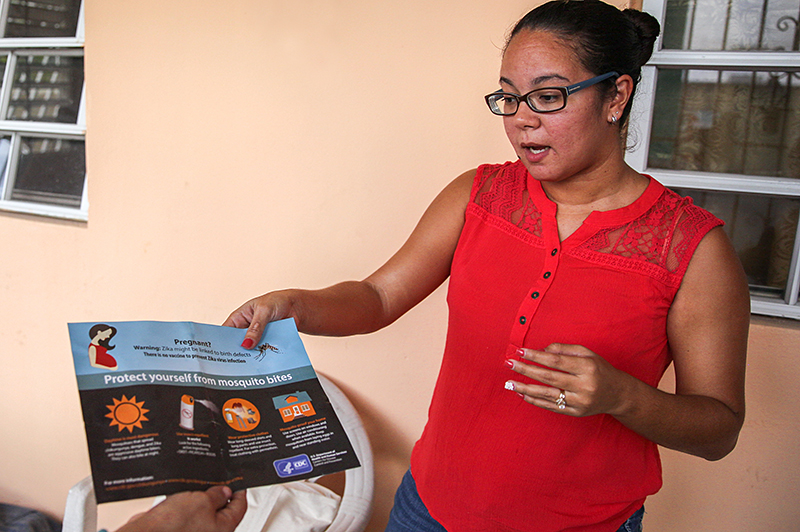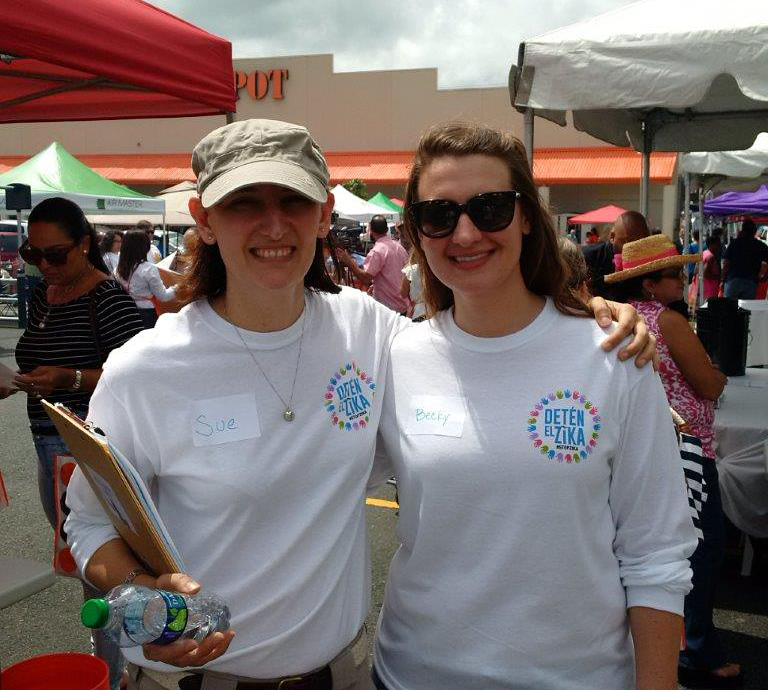You are here
Campaign Empowers Puerto Rican Women, Communities to Stop Zika
Dr. Christine Prue spent 75 days on the ground in Puerto Rico earlier this year, leading a team that interviewed hundreds of pregnant women to gain insights into their perspectives about Zika. Christine, associate director for behavioral science for the National Center for Emerging and Zoonotic Infectious Diseases at the Centers for Disease Control and Prevention (CDC), discovered that while many Puerto Rican women are challenged by their difficult circumstances, they remain resilient, strong and optimistic.
 “Being pregnant is hard. When you add in poverty and the threat of Zika, that’s a lot for anyone to deal with,” said Christine. “Yet even faced with difficult circumstances, the women we met were very optimistic.”
“Being pregnant is hard. When you add in poverty and the threat of Zika, that’s a lot for anyone to deal with,” said Christine. “Yet even faced with difficult circumstances, the women we met were very optimistic.”
Christine recalls a focus group held at a hospital with no air conditioning on the remote Puerto Rican island of Vieques. Women there have to travel to the mainland to give birth because the local hospital has limited resources—a hardship that often disrupts their lives and causes additional stress.
“Life is difficult, but they’re dealing with it. The women I met are problem-solvers,” she said. “They’re concerned about Zika, and the potential effects on their pregnancies, but they can’t do everything themselves to prevent transmission of the virus. They want, and need, help from their partners, their families and others.”
Building on findings from the focus groups, in June 2016 the CDC Foundation launched a Zika education and awareness campaign called “This is How We Stop Zika.” The campaign aimed to empower pregnant women to protect themselves from Zika and was a collaborative effort by CDC and the Puerto Rico Department of Health. The campaign also focused on empowering partners, families, neighbors, and communities to join together to take action to stop the virus from spreading.
Dr. Betsy Mitchell, who served as a principal investigator for the program, is the associate director for communication science for CDC’s National Center on Birth Defects and Developmental Disabilities. The fast-moving campaign is unlike anything she has ever worked on at CDC, including responses to H1N1 influenza and hurricanes, she said.
“What’s different about Zika is that we’re fighting against a disease that can have devastating outcomes, including microcephaly and other severe birth defects, yet most people won’t have symptoms,” she said. “Helping people understand their risk is a real challenge, particularly for people who aren’t pregnant.”
 CDC experts on the ground are learning that it is hard to counteract a threat that lacks the painful, visible symptoms of other mosquito-borne viruses, such as dengue or chikungunya.
CDC experts on the ground are learning that it is hard to counteract a threat that lacks the painful, visible symptoms of other mosquito-borne viruses, such as dengue or chikungunya.
Some clinicians in Puerto Rico are helping to shine a light on the Zika epidemic.
“For example, one doctor who counsels pregnant women pulls out a laminated map, asks a woman where she lives, and then overlays it with nearby cases of Zika,” said Betsy. “It makes the outbreak real and personally relevant.”
In mid-June, Betsy, along with a group of actors, a production crew and team members, worked in the sweltering heat and pop-up rainstorms to complete a public service announcement for the campaign.
“It was dark by the time we finished and we were all drenched with sweat as we exchanged hugs and emotional goodbyes. It was a proud moment because we knew how important it was. Everyone understood their contribution to protecting pregnant women and their fetuses in Puerto Rico and getting the message out.”
 In addition to a multimedia blitz—including media interviews, public service announcements, ads and billboards—the campaign engaged celebrities across the territory and encouraged community involvement through Zika Action Days—which include health fairs and educational workshops—and social media, which continue today.
In addition to a multimedia blitz—including media interviews, public service announcements, ads and billboards—the campaign engaged celebrities across the territory and encouraged community involvement through Zika Action Days—which include health fairs and educational workshops—and social media, which continue today.
“More than 800 people came out to the first Zika Action Day hosted by The Home Depot with the Puerto Rico Department of Health, and I was deeply moved by the community’s engagement and expressions of gratitude to us about the event,” said Betsy. “Many people took extra materials home for their family members, friends, and neighbors. It was very encouraging.”
 CDC estimates that up to one in four Puerto Rico residents, including pregnant women, could be infected with Zika by the end of 2016. “The CDC Foundation stepped in at a critical moment in the outbreak,” added Betsy.
CDC estimates that up to one in four Puerto Rico residents, including pregnant women, could be infected with Zika by the end of 2016. “The CDC Foundation stepped in at a critical moment in the outbreak,” added Betsy.
“We’re especially proud that we were able to include the perspective of pregnant women, their partners, and community members in the campaign development. Including the input of affected communities is critical to communication efforts,” she said. “The CDC Foundation’s ability to rapidly mobilize private-sector partners to fund the campaign allowed us the capacity to do this.”
Funding partners included the Bill & Melinda Gates Foundation, Walgreen Co., and the Annie E. Casey Foundation. Thanks to recent government funding, the campaign continues, following the generous private-sector and philanthropic support that was crucial to its initial phase. Data shows that these messages are encouraging people to take steps to prevent Zika. Additionally, a Community Engagement Resource Toolkit was developed to encourage community members to host events, spark discussion and take action to prevent Zika.
“We are extremely grateful to our generous donors for helping to take this critical initiative to scale,” said CDC Foundation President and CEO Dr. Judy Monroe. “The campaign is carrying and connecting vital messages and resources throughout Puerto Rico to those who need it most.”
Unite with the CDC Foundation to stop Zika.
Photos: © Evelyn Hockstein / CDC Foundation
Zika Action Day photo courtesy of CDC
